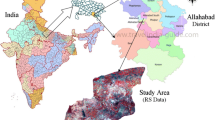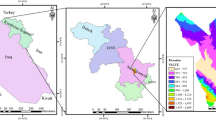Abstract
This study highlights the estimation of soil conservation runoff of the Denwa River Watershed. Remote sensing allied technique was used as dependable and alternative practice to the traditional methods for decision-making process. The major physiographic variables like land use/land cover, soil surface, stream network, water bodies, etc. were analyzed. The outcome of various thematic layers has been synthesized and analyzed to determine hydrological soil group classes to attain curve number. The obtained results demonstrate that the temporal variation in weighted curve number causes differentiation in runoff likely with changes in land use/land cover combined with many soil conditions. In future, this study will be helpful for suitable crop selection, irrigation practice, determining cropping pattern, crop rotation, etc. in the study region.
Access this chapter
Tax calculation will be finalised at checkout
Purchases are for personal use only
Similar content being viewed by others
References
Abhijit MZ, Nagarajan R, Atal KR (2014) Analysis of surface runoff from Yerala River Basin using SCSCN and GIS. IJGG 4(3)
Andrews RG (1954) The use of relative infiltration indices in computing runoff. In: Singh VP (ed) Rainfall-runoff relationship. Water Resources Publications, Littleton, Columbia
Arnold JG, Srinivasan R, Muttiah RS, Wiliams JR (1998) Large area hydrological modelling and assessment part I: model development. J Am Water Resour Assoc 34(1):74–89
Bhuyan SJ, Mankin KR, Koelliker JK (2003) Watershed scale AMC selection for hydrologic modelling. Trans ASAE 46:237–244
Dubayah R, Lerrenmaier D (1997) combing remote sensing and hydrological modelling for applied water and energy balance studies, NASA EOS Interdisciplinary Working Group Meeting, San Diego, CA
Chatterjee C, Jha R, Lohani AK, Kumar R, Singh R (2001) Runoff curve number estimation for a basin using remote sensing and GIS. Asian Pacific Remote Sensing GIS J 14:1–7
Chattopadhyay GS, Choudhury S (2006) Application of GIS and remote sensing for watershed development project-a case study. http://www.gisdevelopment.net
Gajbhiye S (2015) Estimation of surface runoff using remote sensing and geographical information system. Int J u- and e-Serv Sci Technol 8(4):113–122
Gajbhiye S, Mishra SK, Pandey A (2013) A procedure for determination of design runoff curve number for Bamhani watershed. In: IEEE-International conference on advances in engineering and technology (ICAET 2013) 23–25 Jan 2013, pp 1–9
Gajbhiye S, Mishra SK, Pandey A (2013) Effects of seasonal/monthly variation on runoff curve number for selected watersheds of Narmada Basin. Int J Environ Sci 3(6):2035–2046
Mockus V (1949) Estimation of total (peak rates of) surface runoff for individual storms, Exhibit A of Appendix B, Interim Survey Rep. Grand (Neosho) River Watershed, USDA
Moglen GE (2000) Effect of orientation of spatially distributed curve numbers in runoff calculations. J Am Water Resources Assoc 36(6):1391–1400
Sarangi A, Bhattachary AK (2005) Comparison of Artificial Neural Network & regression models for sediment loss prediction from Banha watershed in India. Agric Water Manage 78:195–208
Nagarajan N, Poongothai S (2012) Spatial mapping of runoff from a watershed using SCS-CN method with remote sensing and GIS. J Hydrol Eng 17: 1268–1277 (Special Issue: Soil Conservation Service Curve Number (SCS-CN) Methodology)
SCS (1972, 1985) Hydrology. National Engineering Handbook, Supplement A, Section 4, Chapter 10. Soil Conservation Service, USDA, Washington, DC
Schulze RE, Schmidt EJ, Smithers JC (1992) SCSSA user manual PC based SCS design flood estimates for small catchments in Southern Africa, report No. 40, Department of Agricultural Engineering University of Natal, Pietermaritzburg, South Africa
Ramakrishnan D (2009) SCS-CN and GIS-based approach for identifying potential water harvesting sites in the Kali Watershed, Mahi River Basin India. J Earth Syst Sci 118(4):355–368
Sharma T, Satyakiran PV, Singh TP, Trivedi AV, Navalgund RR (2001) Hydrological response of watershed to Landuse changes: remote sensing and GIS approach. Int J Remote Sensing 22:2095–2108
Ponce VM, Hawkins RH (1996) Runoff curve number: has it reached maturity? J Hydrol Eng ASCE 1(1):11–19
Sharpley AN, Williams JR (1990) EPIC—Erosion/Productivity Impact Calculator: 1 model documentation. US Department of Agriculture Technical Bulletin No. 1768. US Government Printing Office, Washington, DC
Kinsel WG (1980) CREAMS: a field-scale model for chemical, runoff and erosion from agricultural management systems. Conservation Research Report No. 26, South East Area, US Department of Agriculture, Washington, DC
Patil JP, Sarangi A, Singh OP, Singh AK, Ahmad T (2008) Development of a GIS interface for estimation of runoff from watersheds. Water Resour Manage 22(9):1221–1239
Chow VT, Maidment DR, Mayse W (1988) Applied hydrology. Mc-Graw Hill, NY
Author information
Authors and Affiliations
Corresponding author
Editor information
Editors and Affiliations
Rights and permissions
Copyright information
© 2023 The Author(s), under exclusive license to Springer Nature Singapore Pte Ltd.
About this paper
Cite this paper
Karmakar, P., Muley, A., Kulkarni, G., Bhalchandra, P. (2023). Comparative Assessment of Runoff by SCS-CN and GIS Methods in Un-Gauged Watershed: An Appraisal of Denwa Watershed. In: Uddin, M.S., Bansal, J.C. (eds) Proceedings of International Joint Conference on Advances in Computational Intelligence. IJCACI 2022. Algorithms for Intelligent Systems. Springer, Singapore. https://doi.org/10.1007/978-981-99-1435-7_39
Download citation
DOI: https://doi.org/10.1007/978-981-99-1435-7_39
Published:
Publisher Name: Springer, Singapore
Print ISBN: 978-981-99-1434-0
Online ISBN: 978-981-99-1435-7
eBook Packages: Intelligent Technologies and RoboticsIntelligent Technologies and Robotics (R0)




